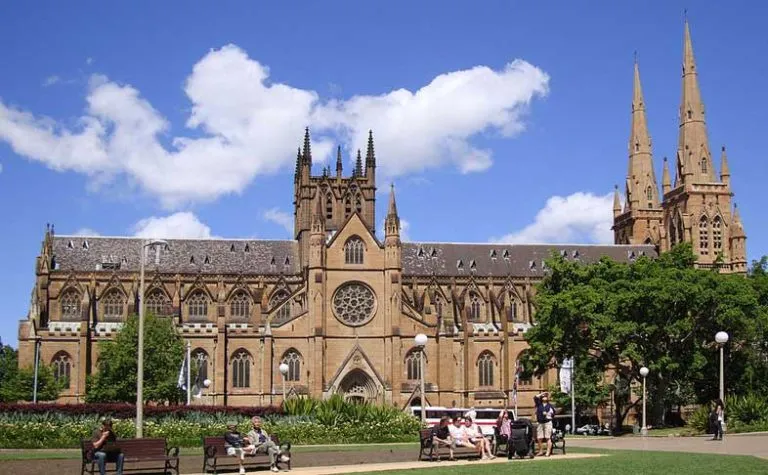
Introduction
Saint Mary’s Cathedral, Sydney is a Sydney landmark and a beacon of hope for those who share the Catholic faith. It is a source of inspiration and the spiritual home of Sydney’s Catholic community.
The Cathedral Church and Minor Basilica of the Immaculate Mother of God, Help of Christians (colloquially, St Mary’s Cathedral) is the cathedral church of the Roman Catholic Archdiocese of Sydney and the seat of the Archbishop of Sydney, currently Anthony Fisher OP. It is dedicated to the “Immaculate Mother of God, Help of Christians”, Patroness of Australia and holds the title and dignity of a minor basilica, bestowed upon it by Pope Pius XI on 4 August 1932.
St Mary’s has the greatest length of any church in Australia (although it is neither the tallest nor largest overall). It is located on College Street near the eastern border of the Sydney central business district in the City of Sydney local government area of New South Wales, Australia. Despite the high-rise development of the central business district, the cathedral’s imposing structure and twin spires make it a landmark from every direction.
In 2008, St Mary’s Cathedral became the focus of World Youth Day 2008 and was visited by Pope Benedict XVI who consecrated the new forward altar. The cathedral was designed by William Wardell and built from 1866 to 1928. It is also known as St Mary’s Catholic Cathedral and Chapter House, Saint Mary’s Cathedral and St Mary’s Cathedral. The property was added to the New South Wales State Heritage Register on 3 September 2004.
History of Saint Mary's Cathedral, Sydney
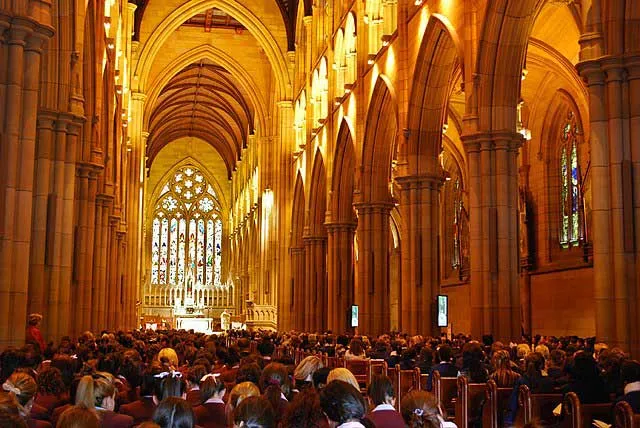
Sydney was established as a penal settlement on 26 January 1788 in the name of King George III by Captain Arthur Phillip, for prisoners transported from Britain. Many of the people to arrive in Sydney at that time were military, some with wives and family; there were also some free settlers. The first chaplain of the colony was the Reverend Richard Johnson of the Church of England. No specific provision was made for the religious needs of those many convicts and settlers who were Roman Catholics. To redress this, an Irish Catholic priest, a Father O’Flynn, travelled to the colony of New South Wales but, as he arrived without government sanction, he was sent home.
It was not until 1820 that two priests, Father Conolly and Father John Therry, arrived to officially minister to the Roman Catholics in Australia. Father Conolly went to Tasmania and Father Therry remained in Sydney. Therry claimed that, on the day of his arrival, he had a vision of a mighty church of golden stone dedicated to the Blessed Virgin Mary raising its twin spires above the city of Sydney. This vision came to pass, but not until after 180 years and three intermediate buildings.
Father Therry applied for a grant of land on which to build a church. He asked for land on the western side of Sydney, towards Darling Harbour. But the land allocated to him was towards the East, adjacent to a number of Governor Lachlan Macquarie’s building projects, the hospital of 1811, the Hyde Park Barracks and St James’ Anglican church which was also used as a law court. The site for the Catholic church overlooked a barren area upon which the bricks for Macquarie’s buildings were made. The area is now Hyde Park, with avenues of trees and the Archibald Fountain.
The foundation stone for the first St Mary’s was laid on 29 October 1821 by Governor Macquarie. Built by James Dempsey, it was a simple cruciform stone structure which paid homage to the rising fashion for the Gothic style in its pointed windows and pinnacles. In 1835, John Polding became the first archbishop of the Roman Catholic Church in Australia. In 1851 the church was modified to the designs of Augustus Welby Pugin. Father Therry died on 25 May 1864. On 29 June 1865, the church caught fire and was destroyed.
The then archdeacon, Father McEnroe, immediately set about planning and fund raising in order to build the present cathedral, based upon a plan drawn up by Archbishop Polding. Polding wrote to William Wardell, a pupil of Augustus Welby Pugin, the most prominent architect of the Gothic Revival movement. Polding was impressed with Wardell’s building of St John’s College at the University of Sydney. In his letter, Polding gives Wardell a completely free hand in the design, saying “Any plan, any style, anything that is beautiful and grand, to the extent of our power.” Wardell had also designed and commenced work on St Patrick’s Cathedral, Melbourne in 1858.

There were to be two intermediate stages. A temporary wooden church was constructed, which was also destroyed by fire in the summer of 1869. The third temporary provision was a sturdy brick building on the site, not of the cathedral but of St Mary’s School, which it was to serve long after the present
Archbishop Polding laid the foundation stone for the present cathedral in 1868. It was to be a huge and ambitious structure with a wide nave and aisle and three towers. Polding did not live to see it in use as he died in 1877. Five years later, on 8 September 1882, his successor, Archbishop Vaughan, presided at the dedication Mass. Archbishop Vaughan gave the peal of bells which were rung for the first time on that day. Vaughan died while in England in 1883.
The cathedral’s builder (for this stage) was John Young, who also built a large sandstone house in the Gothic Revival style, known as “The Abbey”, in Annandale, New South Wales.
But St Mary’s was still far from finished, the work proceeding under Cardinal Moran. In 1913 Archbishop Kelly laid the foundation stone for the nave, which continued under the architects Hennessy, Hennessy and Co. In 1928 Kelly dedicated the nave in time for the commencement of the 29th International Eucharistic Congress. A slight difference of colour and texture of the sandstone on the internal walls marks the division between the first and second stage of building.
Following the death in office of Prime Minister Joseph Lyons in April 1939, he lay in state at St Mary’s for several days before being taken to his home town of Devonport, Tasmania, for burial.
The decoration and enrichment of the cathedral continued with the remains of Archbishop Vaughan being returned to Sydney and buried within the Chapel of the Irish Saints. The richly decorated crypt which enshrines the bodies of many of the early priests and bishops was not completed until 1961 when it was dedicated by Cardinal Gilroy.
For many years the two squared-off towers of the façade gave a disappointing appearance to an otherwise-elegant building. It was from time to time suggested pinnacles should be put up to match the central tower as it appeared plain that William Wardell’s proposed spires would never be built. But with the assistance of a grant from the Government to mark the new millennium, the spires were eventually built in 2000.
In 2008, Saint Mary’s Cathedral became the focus of World Youth Day 2008 and was visited by Pope Benedict XVI who, in his homily on 19 July, made the historic full apology for child sex abuse by Catholic priests in Australia, of whom 107 have been committed by the courts. On 16 December 2014, Archbishop Anthony Fisher invoked the special prayers in the Roman Missal from the “Mass in times of civil disturbance” for the victims of the 2014 Sydney hostage crisis.
A memorial service was held at the cathedral on the morning of 19 December for Tori Johnson and Katrina Dawson, in attendance were the Governor-General Peter Cosgrove, then-Minister of Communications Malcolm Turnbull, Senator Arthur Sinodinos, Premier of New South Wales Mike Baird, and then-Minister of Transport Gladys Berejiklian.
Architecture
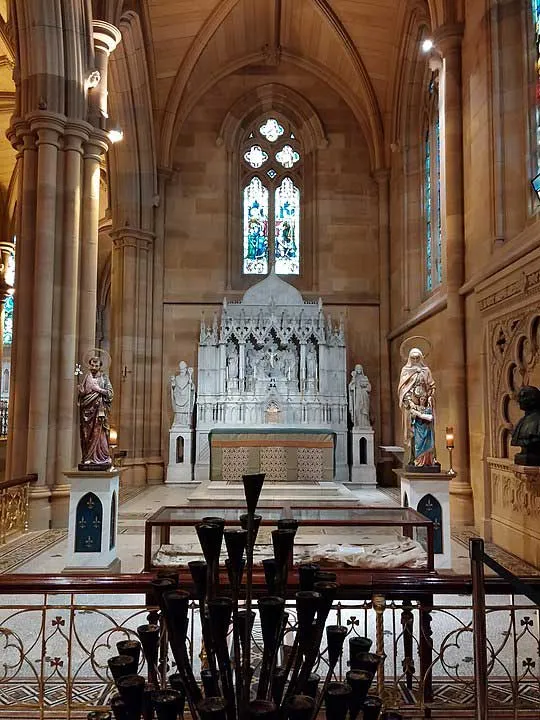
Architectural style: Gothic Revival architecture.
Saint Mary’s Cathedral is unusual among large cathedrals in that, because of its size, the plan of the city around it and the fall of the land, it is oriented in a north–south direction rather than the usual east–west. The liturgical East End is at the north and the West Front is to the south.
The plan of the cathedral is a conventional English cathedral plan, cruciform in shape, with a tower over the crossing of the nave and transepts and twin towers at the West Front (in this case, the south). The chancel is square-ended, like the chancels of Lincoln, York and several other English cathedrals. There are three processional doors in the south with additional entrances conveniently placed in the transept facades so that they lead from Hyde Park and from the presbytery buildings and school adjacent the cathedral.
The architecture is typical of the Gothic Revival of the 19th century, inspired by the journals of the Cambridge Camden Society, the writings of John Ruskin and the architecture of Augustus Welby Pugin. At the time that the foundation stone was laid, the architect Edmund Blacket had just completed Sydney’s very much smaller Anglican cathedral in the Perpendicular Gothic style and the Main Building of Sydney University. St Mary’s, when William Wardell’s plan was realised, was to be a much larger, more imposing and more sombre structure than the smaller St Andrew’s and, because of its fortuitous siting, still dominates many views of the city despite the high-rise buildings.
The style of the cathedral is Geometric Decorated Gothic, the archaeological antecedent being the ecclesiastical architecture of late 13th century England. It is based fairly closely on the style of Lincoln Cathedral, the tracery of the huge chancel window being almost a replica of that at Lincoln.
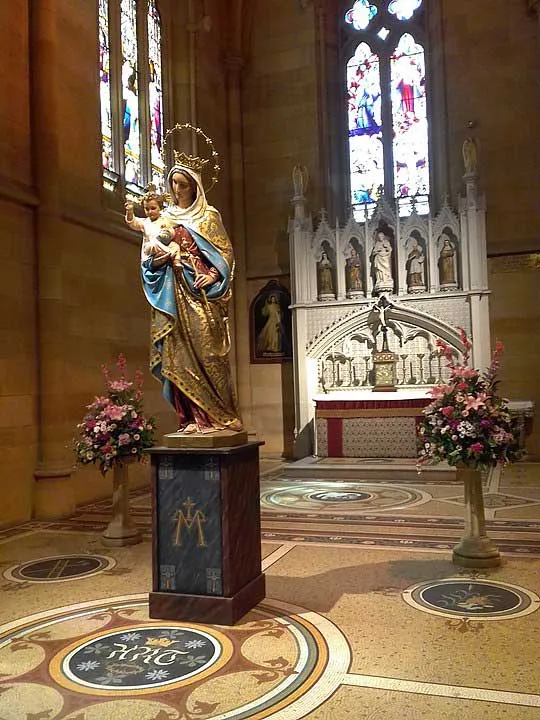
Saint Mary’s Cathedral is generally approached on foot from the city through Hyde Park, where the transept front and central tower rise up behind the Archibald Fountain. During the 20th century the gardeners of Hyde Park have further enhanced the vista by laying out a garden on the cathedral side of the park in which the plantings have often taken the form of a cross.
In cross-section the Cathedral is typical of most large churches in having a high central nave and an aisle on either side, which serve to buttress the nave and provide passage around the interior. The interior of the nave thus rises in three stages, the arcade, the gallery and the clerestory which has windows to light the nave. The building is of golden-coloured sandstone which has weathered externally to golden-brown. The roof is of red cedar, that of the nave being of an open arch-braced construction enlivened by decorative pierced carvings. The chancel is vaulted with timber, which was probably intended to be richly decorated in red, blue and gold after the manner of the wooden roof at Peterborough, but this did not eventuate, and the warm colour of the timber contrasts well with the stonework.
Lighting
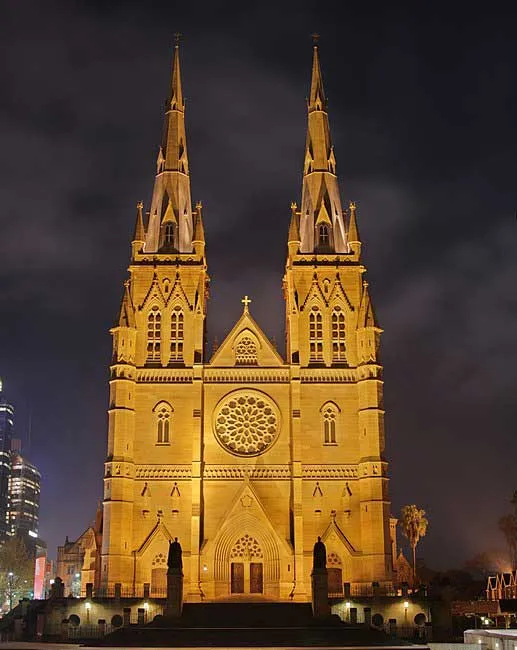
Because of the brightness of Australian sunlight, it was decided at the time of construction to glaze the clerestory with yellow glass. This glazing has darkened over the years, permitting little light to enter. The yellow glazing contrasts with the predominantly blue stained glass of the lower windows. To counteract the darkness, the cathedral installed extensive lighting in the 1970s, designed to give more-or-less equal illumination to all parts of the buildings. The interior is lit with a diffuse yellow glow, which, like the upper windows, is in contrast to the effects of the natural light which penetrates through the white areas of the stained glass. The installed lighting counteracts the pattern of light and shade that would normally exists in a cathedral of the Gothic style by illuminating most brightly those parts of the structure which would normally be subdued.
Stained Glass
The cathedral’s stained glass is all the work of Hardman & Co. and covers a period of about 50 years.
There are about 40 pictorial windows representing several themes and culminating in the chancel window showing the Fall of Man and Mary, crowned and enthroned beside Jesus as he sits in judgement, pleading Jesus’ mercy upon Christians.
Other windows include the mysteries of the rosary, the birth and childhood of Jesus and lives of the saints. Stylistically, the windows move from the Gothic Revival of the 19th century to a more painterly and lavish style of the early 20th century.
Treasures of the Cathedral
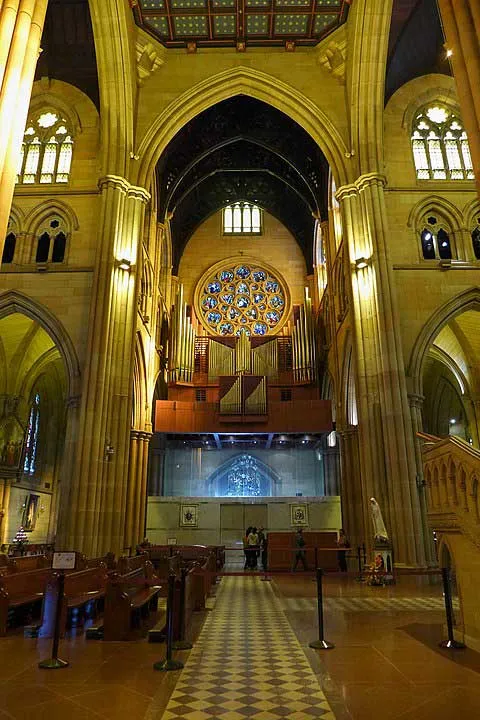
St Mary’s is full of treasures and devotional objects. Around the walls of the aisles are located the Stations of the Cross, painted in oils by L. Chovet of Paris and selected for St Mary’s by Cardinal Moran in 1885. In the western transept is a marble replica of Michelangelo’s Pietà, the original of which is in St. Peter’s Basilica, Rome. This sculpture was brought to Australia for display in David Jones Ltd. department store and was later donated to the cathedral.
Located previously in the crypt, where it was touched in the evening by the setting sun, was the Grave of the Unknown Soldier, a realistic depiction of a dead soldier sculpted by George Washington Lambert. Although previously visible to the public from above, the tomb has now been moved into the aisle of the cathedral, to give the public greater access to it.
The crypt has an extensive mosaic floor, the achievement of Peter Melocco and his firm. This design has as its foundation a cross elaborately decorated like a vast Celtic illuminated manuscript, with rondels showing the Days of Creation and the titles of the Virgin Mary.
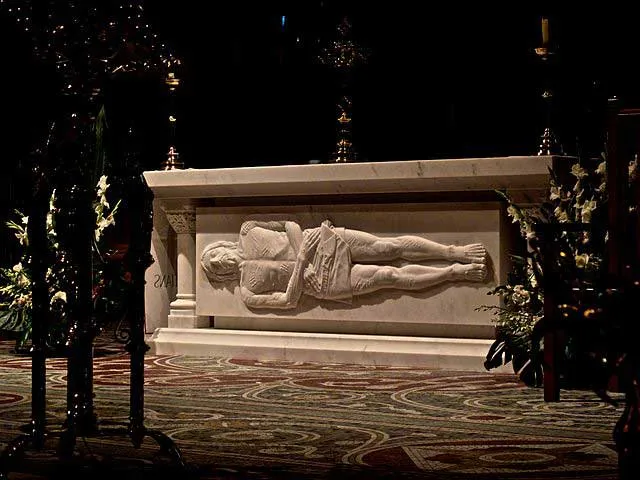
Feast Day – 8th August
Annual Feast Day of St. Mary’s Cathedral held on 8th August.
Mass Time
Weekdays
Saturdays
Sundays
Church Visiting Time
Contact Info
St Marys Road,
Sydney NSW 2000, Australia
Phone No.
Tel : +61 2 9220 0400
Accommodations
How to reach the Cathedral
Sydney Kingsford Smith Airport also known as Sydney International Airport in Sydney, Australia is the nearby Airport to the Cathedral.
St James Train Station in Sydney, Australia is the nearby Train Station to the Cathedral.







